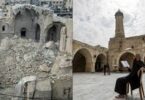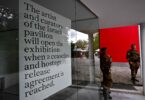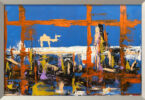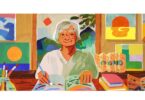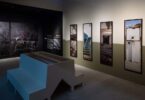Razmig Bedirian
A new group exhibition at The NYU Abu Dhabi Art Gallery puts the concepts of utopia and paradise under the spotlight in a bid to show they are also subject to deterioration and change.
The Only Constant, which opened on Wednesday, takes its cue from the transformative. The exhibition, curated by Maya Allison, executive director at the gallery, was inspired by Al Sawaber, a series of 2015 photographs by Tarek Al-Ghoussein named after a now-demolished housing complex in Kuwait.
The works by the late Kuwaiti-Palestinian artist are displayed early on in the exhibition and show the massive and dense housing project abandoned and left derelict in the days before its demolition. In that way, the photographs are comparable to ones taken in Chernobyl in the wake of the 1986 nuclear disaster or New Orleans after Hurricane Katrina.
But Al Sawaber also evokes a future as imagined in the past. A utopia that has since degraded and become archaic.
“It’s an idea of the future that dates back to the 1970s,” Allison says. “The buildings are futuristic and beveled, in a kind of Jetsons way. They were inspired by the designs of Canadian architect Arthur Erickson, who was well-known for his dramatic and futuristic structures.”
The housing complex in Kuwait, Allison says, was a symbol of how a community space was envisioned in densely-populated areas.
“It was the future of villages, the future of a town, the future and thinking about human habitation and dense areas,” she says. “You could think about this as once upon a time it was a vision of utopia. But by the time he [Al-Ghoussein] gets here, it’s been evacuated because it’s going to be demolished.”
The series also takes viewers to the interior of the structures. Ripped wallpapers depicting natural and garden landscapes reveal the tiles on the walls. In this stacked utopia lay remnants of another imagined paradise, a happy place that beckons — not modernist architectural wonders, but the natural world.
:quality(70)/cloudfront-eu-central-1.images.arcpublishing.com/thenational/MYMOMS7WWWO77BHTHX4GONT7RM.jpg)
“They tell a different story from what the outside says,” Allison says. “There’s a hand-painted plank on a wall that’s now peeled. So, when that was painted, it was somebody’s way of making it their own and decorating it with a reference to nature. So here you are in the Jetson’s idea of the future, painting an image of this paradise that is somewhere else.
“For me, this body of work is where the exhibition came from,” she adds. “It’s when I realised that paradise and utopia are ideas of places we are not at. Paradise that we have lost and utopia, which we have not yet reached. There’s also the question that if you build utopia, do you destroy paradise in the process?”
While Al-Ghoussein’s Al Sawaber encompasses the exhibition’s ambition, each of the collections of works by nine artists examine the dichotomy between natural landscapes and the human imprint with disparate lenses, ranging from the absurd and playful to the dystopic and pensive.
The opening work of the exhibition is Taus Makhacheva’s Ring Road, an installation of dolomite rock and mixed media that displays a model of a mountain in the artist’s home town of Dagestan with a ringed road cut in its mid-section. The road is disconnected from any other road networks.
:quality(70)/cloudfront-eu-central-1.images.arcpublishing.com/thenational/LQG6Y6M7UBBRZG3U3DNVJKZ37U.jpg)
Ring Road can be yours to own for free, but there is a catch. To own the installation, you’d have to enter a legally binding contract to build the proposed road within two years’ time. The contracts are displayed beside the installation, for viewers to pore over before deciding if they want to enter the deal. The proposal is an exercise in absurdism, much like many of Makhacheva’s works, which underscores how we view land as a commodity that we can sever from the earth and stick with a price tag.
From there, the exhibition moves into its Paradise section with a work by Thomas Struth. The German photographerbegan his New Pictures from Paradise series in 1990. The title of the works strikes a paradoxical timbre — that an unchanging, perfect place has changed and that we are now, possibly, being made privy to these transformations.
Struth’s work on display is the third in the series and it shows a dense and lush forest in Australia.
The large-scale work contrasts Wood Wave LXXXIII by Clifford Ross, which depicts — in a triptych of wood panels — a frothy and violent tide. The work creates an interesting tension between two different spans of time, as it depicts a momentary subject, a tide mid-roll, contrasting it with the woodgrains of the panels, which hint at the lifespan of its parent tree.
:quality(70)/cloudfront-eu-central-1.images.arcpublishing.com/thenational/B7ZOOLV6RVGSRFJDYXBGVTRGV4.jpg)
Vivek Vilasini’s City Fifth Investigation, meanwhile, presents a series of 31 works of rice paper that display the gradual pollution buildup in Delhi over a month.
A photographer by practice, Vilasini took a different approach to exposure for these works. He lay the sheets of rice paper on a rooftop in the Indian capital, removing a single sheet a day. The first of the works shows a faint dark outline, which becomes systematically more textured and layered as they reach the end of the month. Bits of rice paper are also torn as a result of rainfall.
“Most of my works deal with the socially relevant,” Vilasini says. “Sometime back we had noticed farmer suicides in India, which, I think, was the first bioindicator that something was wrong with our system. In those days, activists and scientists used to talk about climate change, but it wasn’t yet clear at that time. Now, it is obvious. We are the first generation that is really impacted by climate change. And probably the last generation that can actually do something about it.”
Vilasini wanted to highlight the continued deterioration of environmental health in City Fifth Investigation. It was his attempt at framing the issue.
“I’m not saying we can all solve these problems,” he says. “But we can point and frame, and that’s what mostly what an artist does. They are not actually activists but somewhere in between.”
:quality(70)/cloudfront-eu-central-1.images.arcpublishing.com/thenational/PESQU5UZN5BONILSRTGTT3DAWI.jpg)
The exhibition then takes a closer examination at the destruction the pursuit of utopia leaves in its path. In two parallel videos, artist Patty Chang mourns landscapes and animals that have died due to direct and indirect human influence.
The first work in Invocation for a Wandering Lake shows the artist scrubbing the carcass of a beached whale, in an act alluding to the pre-burial rituals found in many cultures. The second video shows Chang washing a boat that lays on the flat sands of what used to be the bed of the Aral Sea, a lake that lay between Kazakhstan in the north and Uzbekistan. Once the fourth largest lake in the world, the Aral Sea began shrinking in the 1960s due to unsustainable cotton cultivation, before drying up completely in the 2010s.
The concluding piece of the exhibition is its most monumental, sprawling across two exhibition spaces. Haroon Mirza’s Dyson Sphere takes its cue from science fiction writer Olaf Stapledon, who imagined a technology to surround the sun for energy for his 1937 novel Star Maker.
The installation features a light source surrounded by solar panels that feed to a musical contraption featuring a table as well as to a UV light fixture in the next room, which provides sustenance to medicinal flora.
“Ever since the industrial revolution, we’ve always needed more energy,” Allison says. “We’ve gone from coal to oil and now solar. But what happens when we’ve got all the energy we can possibly get, but we need more? The next sort of hypothesis is that we’re going to need to surround the sun with solar panels. If you surround the seven solar panels, you black out your own planet. Electricity creates light, which feeds these plants with UV light.”
Mirza is imagining an absurd future, which we hope never happens. The reason why Mirza chose to highlight medicinal plants is to underscore a pressing question that comes up in this theorised future, Allison says: “If we have limited light to feed our plants, which plants are we going to choose to feed?”
Courtesy: thenationalnews


